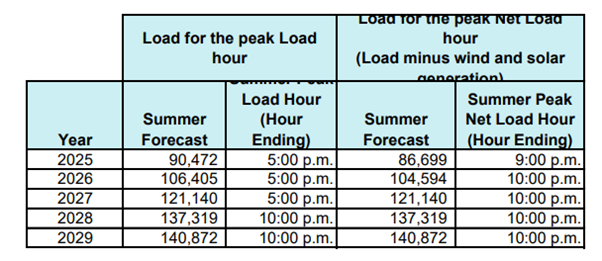News
better business decisions
Posted 10 months ago | 3 minute read

Energy demand may exceed supply in 2026, says ERCOT
ERCOT’s2025-2029 Capacity, Demand and Reserves (CDR) report has forecast that growing demand for power could surpass its available energy supply beginning in summer 2026.
Published on February 13, the report aims to provide a snapshot of potential supply resource availability and demand over the next five years. One scenario in this CDR indicates that Planning Reserve Margins for 2025 through 2029 decrease significantly from year to year, and cross over to negative values in 2026 or 2027. The summer Margins for the peak Net Load hours are lower than for the peak Load hours due mainly to decreasing solar generation availability in the early evening when loads are still high.
Summer peak Load and peak Net Load forecasts for 2025-2029

Source: ERCOT
The shift in the peak load hour to 10:00p.m. beginning in summer 2028 as a result of the growth in price-driven demand response. Price-responsive Loads, such as crypto-currency miners, are expected to interconnect at roughly the same time prior to summer 2028. These loads are anticipated to curtail their consumption through the early evening hours when net loads are typically at their highest and then ramp back up thereafter. This causes the peak load hour and peak net load hour to converge in 2028. The growth in rooftop solar also contributes to the peak hour shift.
The summer peak Net Load hour Margin enters negative territory beginning summer 2026, while the peak Load hour Margin enters negative territory beginning summer 2027. The lower Margins for the peak Net Load hour relative to those for the peak Load hour mainly reflect the lower reliability contribution of solar generation during the evening hours when the peak Net Load occurs. For winter 2027-28, both peak Load and peak Net Load Margins enter negative territory beginning winter 2027-28. Unlike summer, the peak Net Load hour Margins are higher than the peak Load hour Margins. This flip stems from a larger drop-off in early evening loads relative to those experienced during the summer.
The lower and sharply downward trajectory of the Margins is due to:
- high load growth largely driven by new Loads reported by Transmission Service Providers
- a lower capacity contribution from wind and solar resources due to the switch to Effective Load Carrying Capabilities
- fewer planned resources that result from applying additional eligibility criteria to be included in Planning Reserve Margins
- inclusion of planned unit retirements publicly announced but not officially reported as a planned retirement to ERCOT (“Unconfirmed Retirements”)


Source: ERCOT

The rise of the demand side | Global Energy Trends 2025 and Beyond
f climate change, GridBeyond’s latest white paper “The rise of the demand side | Global Energy Trends 2025 and beyond” offers an analysis of the driving forces, emerging trends, and policy frameworks influencing the future of energy systems.
Learn more





